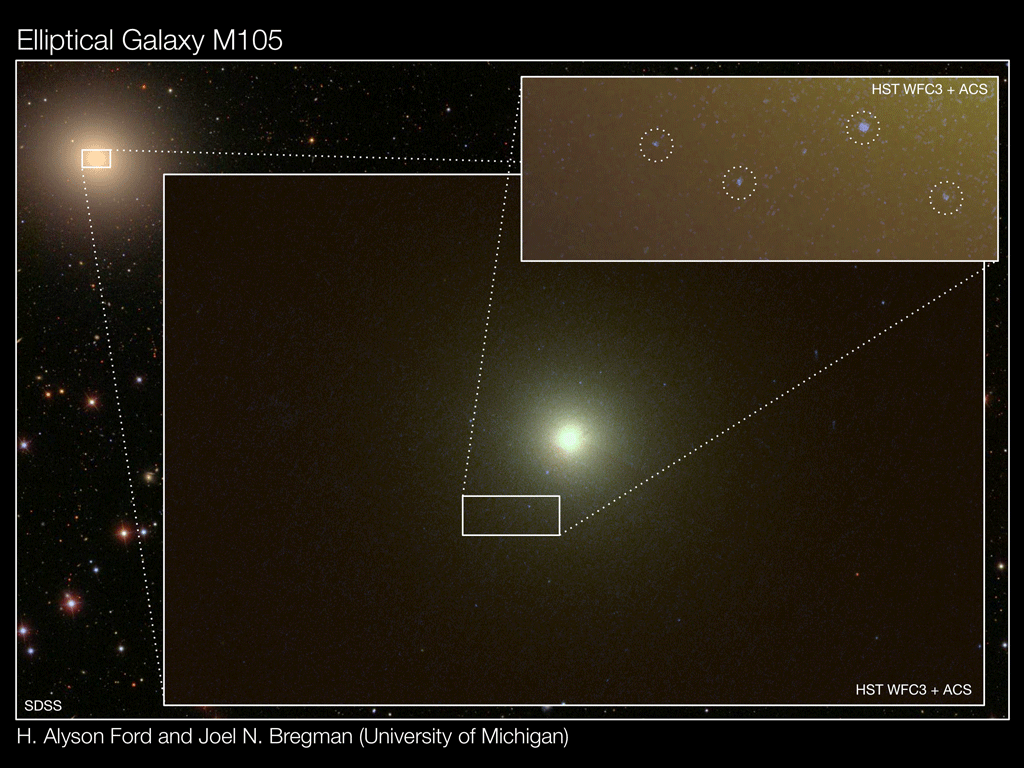Using the Wide Field Camera 3 on the Hubble Space Telescope, Michigan research fellow Alyson Ford and astronomy professor Joel Bregman saw individual young stars and star clusters in four galaxies that are about 40 million light-years away.
“Scientists thought these were dead galaxies that had finished making stars a long time ago,” Ford said. “But we’ve shown that they are still alive and are forming stars at a fairly low level.”
Galaxies generally come in two types: spiral galaxies, like our own Milky Way, and elliptical galaxies. The stars in spiral galaxies lie in a disk that also contains cold, dense gas, from which new stars are regularly formed at a rate of about one sun per year.
Stars in elliptical galaxies, on the other hand, are nearly all billions of years old. These galaxies contain stars that orbit every which way, like bees around a beehive. Ellipticals have little, if any, cold gas, and no star formation was known.
“Astronomers previously studied star formation by looking at all of the light from an elliptical galaxy at once because we usually can’t see individual stars,” Ford said. “Our trick is to make sensitive ultraviolet images with the Hubble Space Telescope, which allows us to see individual stars.”
The technique enabled the astronomers to observe star formation, even if it is as little as one sun every 100,000 years.
Ford and Bregman are working to understand the stellar birth rate and likelihood of stars forming in groups within ellipticals. In the Milky Way, stars usually form in associations containing from tens to 100,000 stars. In elliptical galaxies, conditions are different because there is no disk of cold material to form stars.
“We were confused by some of the colors of objects in our images until we realized that they must be star clusters, so most of the star formation happens in associations,” Ford said.
The team’s breakthrough came when they observed Messier 105, a normal elliptical galaxy that is 34 million light-years away, in the constellation Leo. Though there had been no previous indication of star formation in M105, Ford and Bregman saw a few bright, very blue stars, resembling a single star 10 to 20 times the mass of the Sun.
They also saw objects that aren’t blue enough to be single stars, but instead are clusters of many stars. When accounting for these clusters, stars are forming in M105 at an average rate of one sun every 10,000 years, Ford and Bregman concluded. “This is not just a burst of star formation, but a continuous process,” Ford said.
These findings raise new mysteries, such as the origin of the gas that forms the stars.
“We’re at the beginning of a new line of research, which is very exciting, but at times confusing,” Bregman said. “We hope to follow up this discovery with new observations that will really give us insight into the process of star formation in these ‘dead’ galaxies.”
Using the Wide Field Camera 3 on the Hubble Space Telescope, Michigan research fellow Alyson Ford and astronomy professor Joel Bregman saw individual young stars and star clusters in four galaxies that are about 40 million light-years away.
“Scientists thought these were dead galaxies that had finished making stars a long time ago,” Ford said. “But we’ve shown that they are still alive and are forming stars at a fairly low level.”
Galaxies generally come in two types: spiral galaxies, like our own Milky Way, and elliptical galaxies. The stars in spiral galaxies lie in a disk that also contains cold, dense gas, from which new stars are regularly formed at a rate of about one sun per year.
Stars in elliptical galaxies, on the other hand, are nearly all billions of years old. These galaxies contain stars that orbit every which way, like bees around a beehive. Ellipticals have little, if any, cold gas, and no star formation was known.
“Astronomers previously studied star formation by looking at all of the light from an elliptical galaxy at once because we usually can’t see individual stars,” Ford said. “Our trick is to make sensitive ultraviolet images with the Hubble Space Telescope, which allows us to see individual stars.”
The technique enabled the astronomers to observe star formation, even if it is as little as one sun every 100,000 years.
Ford and Bregman are working to understand the stellar birth rate and likelihood of stars forming in groups within ellipticals. In the Milky Way, stars usually form in associations containing from tens to 100,000 stars. In elliptical galaxies, conditions are different because there is no disk of cold material to form stars.
“We were confused by some of the colors of objects in our images until we realized that they must be star clusters, so most of the star formation happens in associations,” Ford said.
The team’s breakthrough came when they observed Messier 105, a normal elliptical galaxy that is 34 million light-years away, in the constellation Leo. Though there had been no previous indication of star formation in M105, Ford and Bregman saw a few bright, very blue stars, resembling a single star 10 to 20 times the mass of the Sun.
They also saw objects that aren’t blue enough to be single stars, but instead are clusters of many stars. When accounting for these clusters, stars are forming in M105 at an average rate of one sun every 10,000 years, Ford and Bregman concluded. “This is not just a burst of star formation, but a continuous process,” Ford said.
These findings raise new mysteries, such as the origin of the gas that forms the stars.
“We’re at the beginning of a new line of research, which is very exciting, but at times confusing,” Bregman said. “We hope to follow up this discovery with new observations that will really give us insight into the process of star formation in these ‘dead’ galaxies.”










